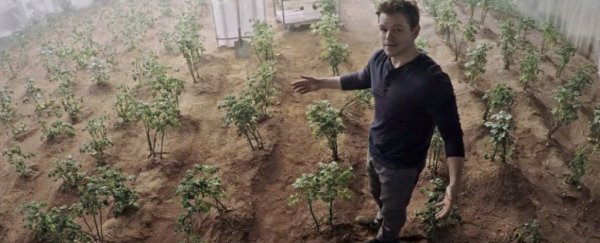Australian scientists have found the gene that allows a native tobacco plant to grow and reproduce in an incredibly short amount of time, and in arid, desert conditions.
If applied to other plants, this gene could be the key to getting crops to survive and grow fast enough in the harsh environment of space, such as on board the International Space Station (ISS), or even in enclosed habitats on Mars. "The plant has worked out how to fight drought – its number one predator – in order to survive through generations," said lead researcher Julia Bally, from Queensland University of Technology (QUT).
The native tobacco plant in question is Nicotiana benthamiana, or Pitjuri as Indigenous tribes call it, and by looking at the fossil record scientists have found that it's been thriving in the harsh Australian climate for around 750,000 years.
The plant also has the unique ability to receive genes from other species and viruses without rejecting them, which makes it the perfect 'lab rat' – and because of this it's been used in labs for genetic testing for decades, acting as a model plant on which to test viruses and vaccines.
This whole time, scientists haven't understood what makes the plant so receptive to novel genes. But the QUT researchers have finally found the answer – and interestingly, it's the same gene that has helped the plant survive in the harsh climate of Australia for so long.
Publishing their results in Nature Plant, the researchers describe a genetic insertion found in Pitjuri, which has completely removed its ability to fight pathogens. The gene literally seems to shut down the plant's desire to fight any invaders, which sounds like a bad thing, but it means that the plant can direct all its energy on growing like mad in a short period of time.
"The plant has lost its 'immune system' and has done that to focus its energies on being able to germinate and grow quickly, rapidly flower, and set seed after even a small amount of rainfall," said Bally. "Its focus is on creating small flowers but large seeds and on getting these seeds back into the soil in time for the next rain. What we found may have a big impact on future plant biotechnology research."
Having no immune system wouldn't be a good thing for crops here on Earth – in a regular farm or plantation these plants would be overrun with pathogens immediately – but it's ideal for sterile environments, such as the lab, or space, according to the researcher team.
"So the recent film The Martian, which involved an astronaut stranded on Mars growing potatoes while living in an artificial habitat, had a bit more science fact than fiction than people might think," said one of the researchers, Peter Waterhouse.
Already scientists are experimenting with growing crops on board the ISS – back in August, astronauts took their first bite of space-grown lettuce. But currently they're working on fine-tuning the wavelengths of lights that could be used to trigger photosynthesis and encourage plant growth.
Knowing the sequence of this gene will also come in handy, as researchers are now able to scan for the gene in other plants, which will allow them to test their potential for rapid growth, and also for use in lab testing.
And in the future, if scientists could insert the genetic mutation from Pitjuri into other crops, they would be able to ramp up production far more rapidly and potentially be able to feed astronauts with fresh food in just days of arrival.
There's a lot of work to be done before this gene can be incorporated into other species – and there's also the issue of people's reluctance towards genetically modified food crops to contend with. But we think if this is the only option we have for getting plants to grow fast enough to feed a colony on Mars, maybe there'll be less objection. We'll have to wait and see.
Find out more about the study in the video that came out with the paper:

QUT are sponsors of ScienceAlert. Find out more about their research.
